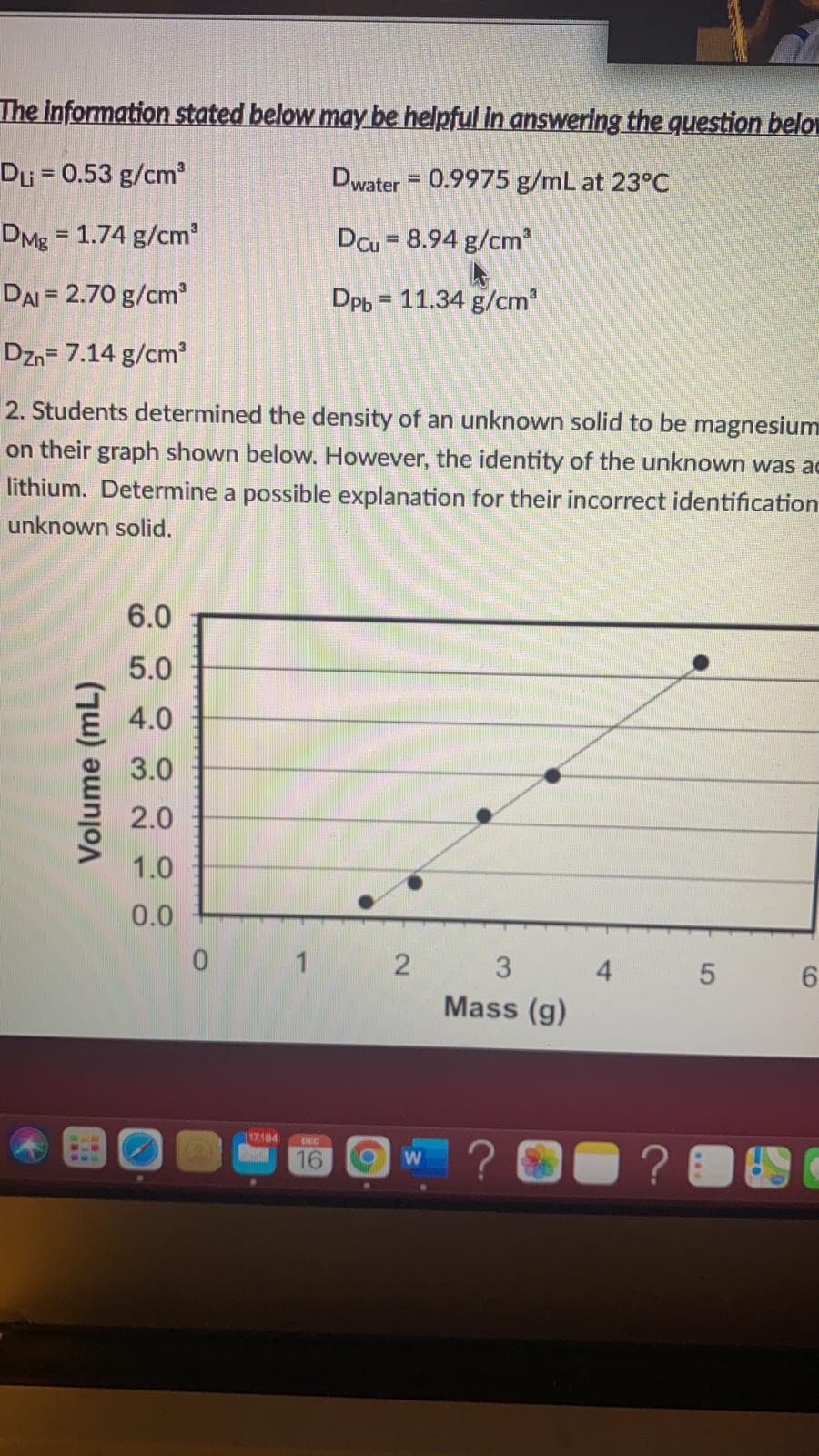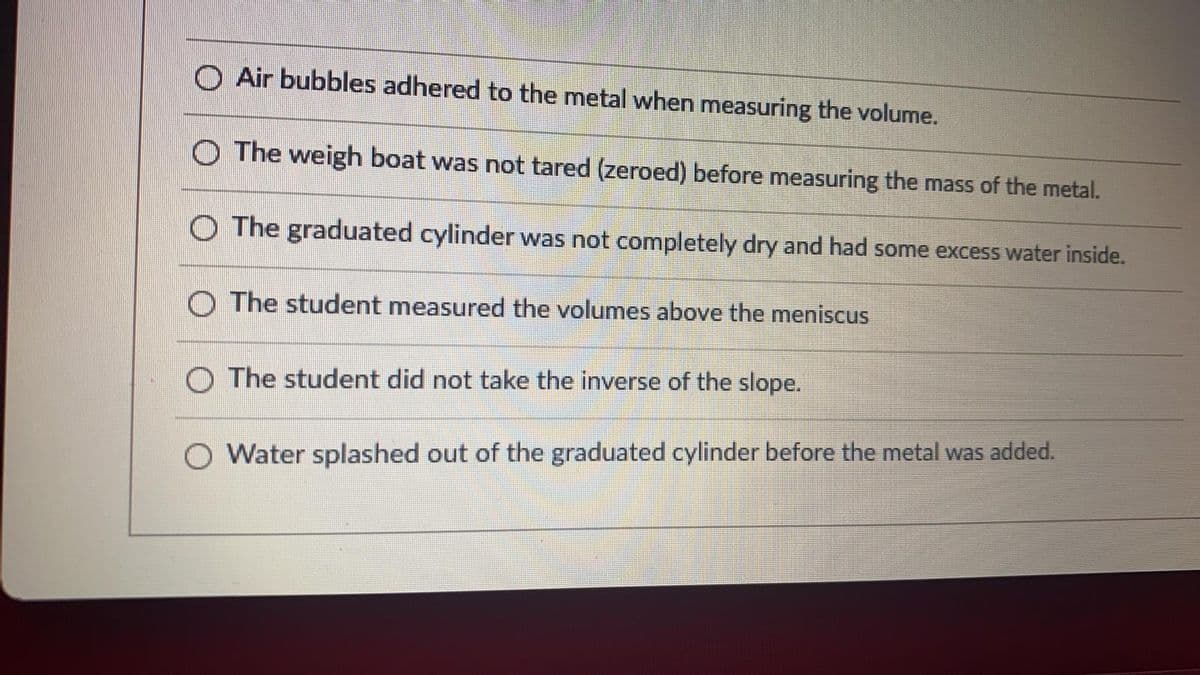The information stated below may be helpful in answering the question belc Du = 0.53 g/cm Dwater = 0.9975 g/mL at 23°C %3D DMg = 1.74 g/cm' DCu = 8.94 g/cm %3D DAI = 2.70 g/cm DPb = 11.34 g/cm %3D Dzn= 7.14 g/cm 2. Students determined the density of an unknown solid to be magnesiun on their graph shown below. However, the identity of the unknown was a lithium. Determine a possible explanation for their incorrect identification unknown solid. 6.0 5.0 4.0 3.0 2.0 1.0 0.0 1 4 5 Mass (g) Volume (mL)
The information stated below may be helpful in answering the question belc Du = 0.53 g/cm Dwater = 0.9975 g/mL at 23°C %3D DMg = 1.74 g/cm' DCu = 8.94 g/cm %3D DAI = 2.70 g/cm DPb = 11.34 g/cm %3D Dzn= 7.14 g/cm 2. Students determined the density of an unknown solid to be magnesiun on their graph shown below. However, the identity of the unknown was a lithium. Determine a possible explanation for their incorrect identification unknown solid. 6.0 5.0 4.0 3.0 2.0 1.0 0.0 1 4 5 Mass (g) Volume (mL)
Chapter12: The Liquids And Solids Around Us: Especially Water
Section: Chapter Questions
Problem 51E
Related questions
Question

Transcribed Image Text:The information stated below may be helpful in answering the question belo
DU3D0.53 g/cm
Dwater 0.9975 g/mL at 23°C
DMg = 1.74 g/cm
Dcu = 8.94 g/cm
DAI = 2.70 g/cm
DPb = 11.34 g/cm
%3D
Dzn= 7.14 g/cm
2. Students determined the density of
unknown solid to be magnesium
on their graph shown below. However, the identity of the unknown was ac
lithium. Determine a possible explanation for their incorrect identification
unknown solid.
6.0
5.0
4.0
3.0
2.0
1.0
0.0
1 2
3
4.
Mass (g)
17184
DEC
16
Volume (mL)

Transcribed Image Text:O Air bubbles adhered to the metal when measuring the volume.
O The weigh boat was not tared (zeroed) before measuring the mass of the metal.
O The graduated cylinder was not completely dry and had some excess water inside.
O The student measured the volumes above the meniscus
O The student did not take the inverse of the slope.
O Water splashed out of the graduated cylinder before the metal was added.
Expert Solution
This question has been solved!
Explore an expertly crafted, step-by-step solution for a thorough understanding of key concepts.
This is a popular solution!
Trending now
This is a popular solution!
Step by step
Solved in 3 steps

Knowledge Booster
Learn more about
Need a deep-dive on the concept behind this application? Look no further. Learn more about this topic, chemistry and related others by exploring similar questions and additional content below.Recommended textbooks for you


Chemistry: Matter and Change
Chemistry
ISBN:
9780078746376
Author:
Dinah Zike, Laurel Dingrando, Nicholas Hainen, Cheryl Wistrom
Publisher:
Glencoe/McGraw-Hill School Pub Co

Chemistry & Chemical Reactivity
Chemistry
ISBN:
9781337399074
Author:
John C. Kotz, Paul M. Treichel, John Townsend, David Treichel
Publisher:
Cengage Learning


Chemistry: Matter and Change
Chemistry
ISBN:
9780078746376
Author:
Dinah Zike, Laurel Dingrando, Nicholas Hainen, Cheryl Wistrom
Publisher:
Glencoe/McGraw-Hill School Pub Co

Chemistry & Chemical Reactivity
Chemistry
ISBN:
9781337399074
Author:
John C. Kotz, Paul M. Treichel, John Townsend, David Treichel
Publisher:
Cengage Learning

Chemistry & Chemical Reactivity
Chemistry
ISBN:
9781133949640
Author:
John C. Kotz, Paul M. Treichel, John Townsend, David Treichel
Publisher:
Cengage Learning

World of Chemistry, 3rd edition
Chemistry
ISBN:
9781133109655
Author:
Steven S. Zumdahl, Susan L. Zumdahl, Donald J. DeCoste
Publisher:
Brooks / Cole / Cengage Learning

Introductory Chemistry: A Foundation
Chemistry
ISBN:
9781337399425
Author:
Steven S. Zumdahl, Donald J. DeCoste
Publisher:
Cengage Learning